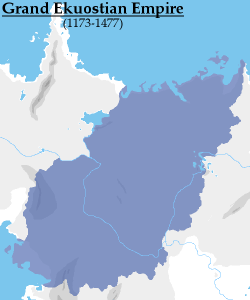Grand Ekuostian Empire
Revision as of 19:19, 29 January 2016 by Ultimate Ridley (talk | contribs) (Ultimate Ridley moved page Grand Ekuosian Empire to Grand Ekuostian Empire: Name change)
| Grand Ekuosian Empire | |||||
| Ekuostasudsímb | |||||
| |||||
The max extent of the GEE, in 1225.
| |||||
| Capital | Terydnunekuos | ||||
| Languages | Middle Ekuosian, Old Dzimraic, Azri, Old Lonish | ||||
| Religion | Iovism | ||||
| Government | Absolute Monarchy | ||||
| Grand Emperor | |||||
| • | 1173-1231 | Ástlem Yobátmás | |||
| • | 1231-1284 | Otímsu I | |||
| • | 1284-1326 | Koruos | |||
| • | 1326-1375 | Otímsu II | |||
| • | 1375-1411 | Gerut the Brave | |||
| • | 1411-1459 | Norusaít | |||
| • | 1459-1487 | Mástát | |||
| Historical era | Middle Ages | ||||
| • | Proclaimed | 6 February 1173 | |||
| • | Collapsed | 17 April 1487 | |||
| b. | ... | ||||
The Grand Ekuosian Empire (Ekuosian: Ekuostasudsímb, IPA: /ekwʌst̪ɑs̪ud̪s̪y:mb/) was a large empire in Northwest Baredina that flourished during the Middle Ages. It was proclaimed in 1173 by King Ástlem Yobátmás of the former Kingdom of Ekuos, who then became immortalized as Ekuos's yomtasudsí (founding ruler). The empire was proclaimed and grew at an alarming rate in the name of Iovism, namely trying to stamp out the Adzamasiin religion which remained ever popular in the region even centuries after the collapse of the Adzamasi Empire. After Ástlem's death in 1231, however, the empire began a slow and steady decline until eventually, by 1487, all it had left was Ekuos and Dzimur.
